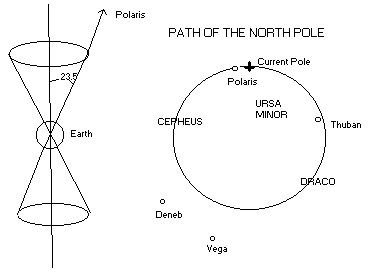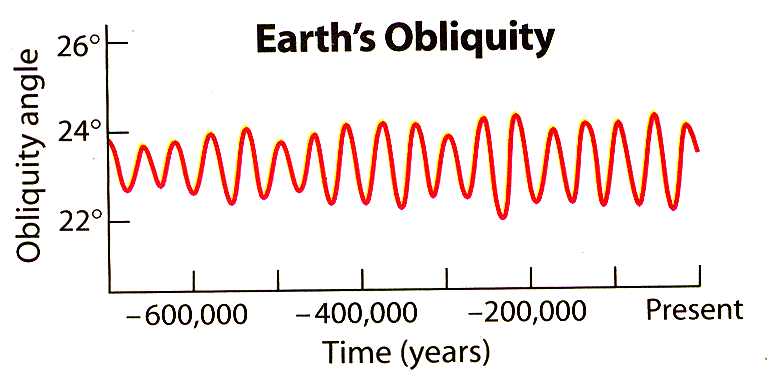
In this wobble motion, the tilt of the earth stays roughly constant at 23.4 degrees but the orientation is always changing.

One consequence of precession is that the north star Polaris is drifting. It is only "north star" by coincidence today. Vega will be our north star for a time in the distant future.
Another consequence is that precession introduces a difference between a sidereal (real) year and a tropical (by the sun) year because during the course of one year the position of the equinox changes slightly.
The physical cause of the precession is a torque (twisting) of the earth, caused mostly by the sun's and the moon's gravity pulling on the equatorial bulges of the earth. If earth were NOT spinning, the sun and moon would pull the earth so that the bulges were flat in the sun-earth orbital plane.
The planets have some gravitational influence also, but insignificant compared to the sun and moon. Still, the planets manage to cause the orbit of earth about the sun to precess and morph. The inclination of Earth's orbit varies with respect to the solar system's invariant plane with a period of roughly 71000 years. Apsidal (Earth's orbit's major axis) precession P = 112,000 yr, combines with the 25,770 yr precession to make it about 21,630 years for the Vernal Equinox to cycle 360 degrees. Planetary perturbations also cause an oscillation in the ellipticity of earth's orbit whose main component 413,000 year long, in which the eccentricity varies from its mean of 0.0019 by +/- 0.012.
Taken in conjunction with the 26000-year spin-axis precession, the 71000-year orbit precession causes a 41000-year oscillation in the tilt of the earths axis, about plus or minus 1.3 degrees from its average value of 23.3 degrees. This number is not absolutely stable - it depends on the combined positions of all the planets through time. The obliquity (tilt) for the last 600,000 years is shown below.

The tilt reached a maximum of 24.2 degrees about 9500 years ago, and has been decreasing ever since. The tilt is now near the average value, but the rate of change of the obliquity is near a maximum.
The most startling consequence of this is that the tropics (the tropics of Cancer and Capricorn, where the most northerly or southerly vertical rays of the sun strike) are MOVING TOWARD THE EQUATOR. The rate is more than 14 meters per year! Example: the government of Taiwan erected a monument in a park marking the tropic in 1908. The actual tropic is now more than a kilometer south of this location! The arctic circles are likewise travelling toward their respective poles. The temperate zones gain 1550 square kilometers of territory every year!
Another consequence may be seen in climactic data from oxygen isotope data: there a appears to be a cyclic climate pattern with a 41,000-year period, one of the so-called Milankovitch cycles. This can be qualitatively understood: when the obliquity is low, the polar regions get less sunlight, cool, and accumulate ice and snow. The total amount of sunlight caught by the earth remains the same, so it is premature to positively identify obliquity changes as the root cause of the ice ages.